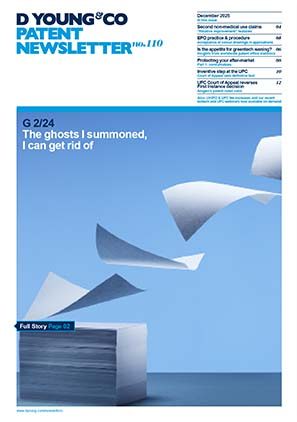Hot topics, cool solutions: patenting air conditioning technology at the EPO
There is a rising demand for air conditioning across Europe, driven by a change in the climate: extreme heat is now more likely to be experienced in Europe than ever before. An increasing number of people are now relying on air conditioning to ensure a comfortable environment at home and in the workplace.
Paradoxically, air conditioning is often viewed as one of the key contributors to climate change, since running air conditioning units can require a large amount of electricity.
Accordingly, there is a need for further development of air conditioning technology. Patents play a critical role in this regard, as they protect investment and encourage further innovation.
In this article we take a look at some of the different ways in which improvements in the efficiency of air conditioning can be achieved. Furthermore, we consider the extent to which these improvements can be protected with patents at the European Patent Office (EPO), offering protection for inventions across European markets.
Areas of development
Air conditioning technology has come a long way since its inception. Traditionally, air conditioning has been achieved through non-inverter technology. With non-invertor technology, the compressor operates at a constant speed. The compressor is then switched on and off in a cycle in order to regulate the temperature. However, modern air conditioning units often use invertor technology. With invertor technology, the speed of the compressor motor can be controlled (as opposed to merely being switched on and off) which enables a continuous regulation of the temperature.
Invertor air conditioning technology provides significant efficiency improvements over non-invertor technology. However, even with invertor air conditioning technology, there is still scope for further improvements in efficiency. In particular, there is interest in providing more precise control of the speed of the compressor motor to further increase the efficiency of the air conditioning unit. Furthermore, there is interest in linking the air conditioning unit to the wider Internet of Things, enabling enhanced control of the air conditioning unit and more efficient energy consumption.
The refrigerants which are used by the air conditioning units are also a focus of potential innovation. For example, there is interest in developing more environmentally friendly and efficient refrigerants to those refrigerants which are traditionally used in air conditioning units (such as R-410A). Indeed, some of these changes are being driven by government regulation.
In the remainder of this article, we will focus on the first two of these areas of innovation (precise control of the speed of the compressor motor and integration of air conditioning units with the Internet of Things).
Patentability at the EPO
To successfully patent inventions at the EPO an applicant must demonstrate that their invention is both novel and involves an inventive step.
The requirement for an invention to be novel means that the invention must be different than what has been previously disclosed in the prior art. In an area of technology such as air conditioning (an active area of innovation) there can be a significant amount of prior art cited against an invention. However, a single point of difference is sufficient to demonstrate novelty over the prior art. Many inventions are based on incremental improvements on previous technology.
Therefore, a new way of controlling the speed of the compressor motor would likely be sufficient to demonstrate novelty of the invention (even though control of the speed of the compressor motor itself may be known from the prior art). Likewise, a new way of controlling an air conditioning unit by connection, through the internet, to environmental sensors or by connection to an application stored on a user device (such as a smart phone) may also be sufficient to demonstrate novelty of the invention.
On the other hand, inventive step at the EPO is a question of whether the invention would be obvious for the skilled person in view of the prior art. At the EPO, inventive step is assessed through the so-called problem-solution approach. An examiner will assess whether the novel features of an invention provide a technical effect (and thus solve a technical problem). If the novel features solve a technical problem, the examiner will then assess whether the solution to this technical problem would be obvious for the person skilled in the art (for example, an invention may be considered to lack an inventive step if a prior art document teaches these novel features as a solution to the problem). Accordingly, the technical problem being addressed by an invention is very important during assessment of inventive step at the EPO.
For an air conditioning invention, a technical problem may be a problem such as how to improve the efficiency of the air conditioning unit. If a new way of controlling an air conditioning unit through a connection to the Internet of Things improved the efficiency of the air conditioning unit during operation, it may be possible to demonstrate an inventive step. However, if the new way of controlling the air conditioning unit did not provide such an improvement over the prior art, it may be very difficult to demonstrate an inventive step.
Of course, the technical problem being solved is not limited to improvements in efficiency of operation of the air conditioning unit. Other technical problems which could be addressed may include ways of reducing the size or form factor of an air conditioning unit, ways of reducing the noise generated by an air conditioning unit, or ways of improving the reliability of the air conditioning unit. These are all examples of technical problems which may contribute to inventive step at the EPO.
On the other hand, advantages such as aesthetic improvements in the appearance of the air conditioning unit or certain types of improvements to a user interface for controlling the air conditioning unit may not necessarily be considered to provide a technical effect solving a technical problem which can contribute to inventive step at the EPO.
Therefore, when drafting a patent application to protect an invention, it is crucially important to focus on the technical problem which is being solved by the invention to increase the chances of that invention being favourably considered by the examiner during the assessment of inventive step. The application should be drafted in such a way to clearly explain how the technical features of the invention address the underlying problem which is being solved.
Final thoughts
Climate change is set to make European markets increasingly important for air conditioning technology. Regulatory pressure will likely drive innovation, as governments introduce restrictions on the energy efficiency of devices in order to comply with climate goals.
Market leaders will therefore want to continue to protect their commercial interests in Europe, and patents can play a key role in achieving this. When drafting a patent application, a key focus must remain on the technical problem being solved by the invention: does it provide more advanced cooling or further improvements in energy efficiency, for example?
Ultimately, as demand for efficient and sustainable cooling grows, the role of patents at the EPO remains central, not only in protecting innovation but also in helping to shape a cooler, more sustainable future, for homes, workplaces and beyond.

